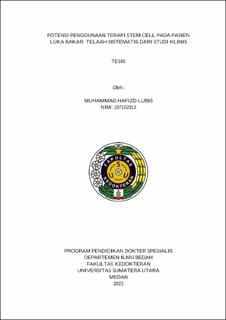Potensi Penggunaan Terapi Stem Cell pada Pasien Luka Bakar: Telaah Sistematis dari Studi Klinis

Date
2023Author
Lubis, Muhammad Hafizd
Advisor(s)
Prananda, Arya Tjipta
Nasution, Iqbal Pahlevi Adeputra
Metadata
Show full item recordAbstract
Background: Burns have a high degree of vascular permeability, but their healing follows the general paradigm for all wounds. The reparative process in burns begins with an inflammatory response, which is histologically characterized by infiltration of neutrophils and macrophages. Various kinds of research have been and continue to be carried out, to address and find the best methods for dealing with burn problems and how to get a method that can speed up the healing process of burns, one of which is stem cell therapy.
Methods: This research was conducted with a systematic review using secondary data from the results of previous studies and selecting the results of the research trials within the time span from 2002-2022 at the Department of Surgery, Division of Urology, Haji Adam Malik General Hospital, Medan. This research was conducted at Haji Adam Malik General Hospital in Medan after being approved by the Research Ethics Committee.
Results: From several journals that have been obtained, wound healing is influenced by several complex biological factors consisting of hemostasis, inflammation, proliferation, and remodeling. A large number of cell types—including neutrophils, macrophages, lymphocytes, keratinocytes, fibroblasts, and endothelial cells—are involved in the wound healing process in burn patients. Various factors can impair wound healing by affecting one or more phases of the process and are categorized into local and systemic factors.
Conclusion: The influence of these factors is not mutually exclusive. One or several factors may play a role in one or more individual phases, contributing to the overall outcome of the healing process.
Collections
- Master Theses [204]
